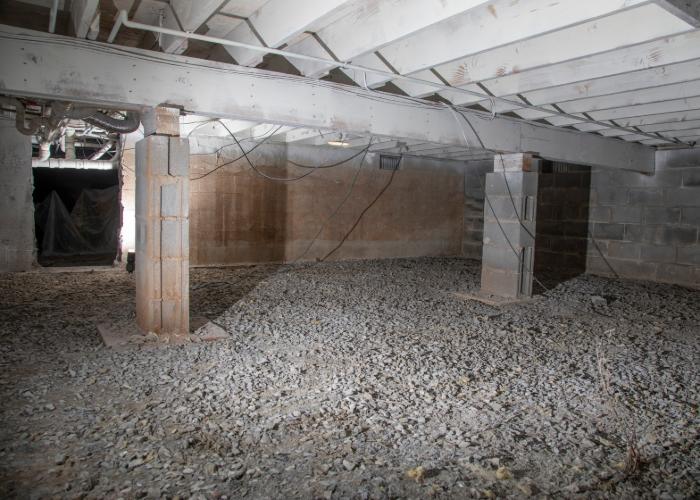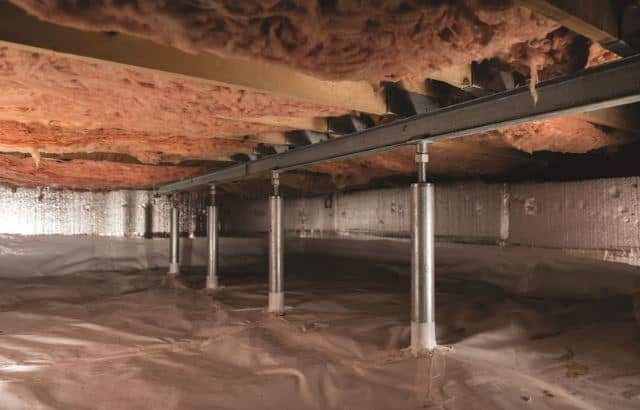Crawlspaces, often overlooked, are integral parts of a building’s structure. Properly managing and waterproofing these areas is crucial to maintaining a healthy home environment and preserving the building’s integrity. Crawlspace waterproofing involves various techniques and strategies to prevent water infiltration, mold growth, and structural damage. This comprehensive guide will delve into the importance of crawlspace waterproofing, common problems, and effective solutions.
Understanding Crawlspace Water Problems
Crawlspaces are prone to moisture issues due to their location and construction. These spaces are typically found beneath homes and can accumulate moisture from several sources:
- Groundwater: Rising water tables or heavy rains can cause groundwater to seep into crawlspaces.
- Surface Water: Poor drainage around the home’s foundation can lead to water pooling and eventually entering the crawlspace.
- Condensation: Temperature differences between the crawlspace and the exterior can cause condensation on surfaces.
- Internal Sources: Leaks from plumbing or HVAC systems can introduce moisture into the crawlspace.
Signs of Crawlspace Water Problems
Identifying moisture problems early is key to preventing extensive damage. Common signs of crawlspace water issues include:

- Musty odors
- Visible mold or mildew
- Standing water or dampness
- Wood rot or rusting metal components
- Pest infestations (termites, rodents, etc.)
- High indoor humidity levels
- Sagging or uneven floors above the crawlspace
The Importance of Crawlspace Waterproofing
Waterproofing a crawlspace is essential for several reasons:
- Structural Integrity: Moisture can weaken wooden beams and joists, leading to structural damage.
- Health Concerns: Damp environments promote mold growth, which can cause respiratory issues and other health problems.
- Energy Efficiency: Moist crawlspaces can increase heating and cooling costs by allowing conditioned air to escape.
- Property Value: A dry, well-maintained crawlspace enhances the overall value and appeal of a home.
Methods of Crawlspace Waterproofing
There are several methods to waterproof a crawlspace, ranging from simple DIY solutions to professional interventions. The most effective approach often involves a combination of techniques tailored to the specific conditions of the crawlspace.
Exterior Waterproofing Solutions
- Proper Grading and Landscaping
Ensuring that the ground slopes away from the foundation helps prevent surface water from pooling near the crawlspace. This involves:
- Regrading the soil around the foundation to create a slope
- Installing gutters and downspouts to direct water away from the house
- Using downspout extensions to carry water further away
- French Drains
French drains are trenches filled with gravel and a perforated pipe that redirects groundwater away from the foundation. They can be installed around the perimeter of the house to intercept and channel water away from the crawlspace.
- Exterior Waterproof Membranes
Applying waterproof membranes to the exterior foundation walls can prevent water from seeping into the crawlspace. These membranes create a barrier that repels moisture and protects the foundation.
Interior Waterproofing Solutions
- Vapor Barriers
Installing a vapor barrier on the crawlspace floor and walls is one of the most effective ways to control moisture. Vapor barriers are typically made of heavy-duty plastic sheeting that blocks moisture from the ground and walls. Proper installation involves:
- Covering the entire floor with the barrier, overlapping seams by at least 12 inches
- Sealing the barrier to the foundation walls and piers with tape or adhesive
- Extending the barrier up the walls by at least 6 inches
- Encapsulation
Encapsulation involves completely sealing the crawlspace with a combination of vapor barriers and insulation. This method creates a controlled environment that prevents moisture from entering. Encapsulation steps include:
- Installing a vapor barrier on the floor and walls
- Sealing all vents and openings
- Adding insulation to the walls and/or floor joists
- Installing a dehumidifier to control humidity levels
- Interior Drainage Systems
An interior drainage system, such as a perimeter drain, can help manage water that enters the crawlspace. These systems typically include:
- A perforated pipe installed along the interior perimeter of the crawlspace
- A sump pump to collect and remove water from the drainage pipe
- A discharge line to direct water away from the foundation
- Sump Pumps
Sump pumps are essential for crawlspaces with persistent water issues. These pumps collect water from the interior drainage system or directly from the crawlspace floor and pump it outside. Key features of a sump pump system include:
- A sump pit to collect water
- A reliable pump with battery backup for power outages
- An alarm system to alert homeowners of potential failures
Additional Preventive Measures
In addition to waterproofing methods, homeowners can take several preventive measures to minimize the risk of moisture problems in their crawlspaces:
- Regular Inspections
Conducting regular inspections of the crawlspace can help identify potential issues before they become severe. Homeowners should look for signs of water infiltration, mold growth, and structural damage.
- Plumbing Maintenance
Regularly inspecting and maintaining plumbing systems can prevent leaks and water damage in the crawlspace. Homeowners should:
- Check for leaks or damage in pipes and fixtures
- Insulate pipes to prevent condensation
- Install water alarms to detect leaks early
- Ventilation
Proper ventilation can help control moisture levels in the crawlspace. However, in humid climates, venting can introduce more moisture. Homeowners should consider:
- Using crawlspace vents with adjustable openings
- Installing vent fans to improve air circulation
- Sealing vents and using mechanical dehumidification in particularly humid areas
- Gutter and Downspout Maintenance
Ensuring that gutters and downspouts are clean and functional can prevent water from pooling near the foundation. Regular maintenance involves:
- Cleaning gutters to remove debris
- Checking for leaks or damage
- Ensuring downspouts are directed away from the foundation
Case Studies: Successful Crawlspace Waterproofing
- Historic Home in a Humid Climate
A homeowner of a historic home in a humid climate faced persistent crawlspace moisture issues. The solution involved a comprehensive encapsulation system, including:
- Installing a vapor barrier on the floor and walls
- Sealing all vents and openings
- Adding insulation to the walls
- Installing a dehumidifier to control humidity levels
This approach successfully eliminated moisture problems and preserved the structural integrity of the historic home.
- New Construction in a Flood-Prone Area
A new construction project in a flood-prone area required proactive crawlspace waterproofing measures. The builders implemented several strategies, including:
- Grading the landscape to slope away from the foundation
- Installing French drains around the perimeter
- Applying exterior waterproof membranes to the foundation walls
- Installing a sump pump with a battery backup system
These measures ensured that the crawlspace remained dry, even during heavy rains and flooding events.
The Role of Professionals in Crawlspace Waterproofing
While some crawlspace waterproofing methods can be tackled by homeowners, others require professional expertise. Hiring a professional ensures that the job is done correctly and provides long-term protection. Professional services typically include:

- Assessment and Diagnosis
Professionals can accurately assess the condition of the crawlspace and identify the source of moisture problems. This involves:
- Conducting a thorough inspection
- Using moisture meters and infrared cameras to detect hidden issues
- Providing a detailed report with recommended solutions
- Installation and Repairs
Professionals have the skills and tools to install waterproofing systems effectively. They can:
- Install vapor barriers and encapsulation systems
- Set up interior and exterior drainage systems
- Install and maintain sump pumps
- Repair foundation cracks and leaks
- Maintenance and Monitoring
Regular maintenance and monitoring are crucial for ensuring the effectiveness of crawlspace waterproofing systems. Professional services include:
- Conducting periodic inspections
- Maintaining and servicing sump pumps and drainage systems
- Monitoring humidity levels and making adjustments as needed
Crawlspace waterproofing is a vital aspect of home maintenance that protects against water damage, mold growth, and structural issues. By understanding the sources of moisture problems and implementing appropriate waterproofing methods, homeowners can ensure a dry, healthy living environment. Regular inspections, preventive measures, and professional assistance further enhance the effectiveness of waterproofing efforts, providing peace of mind and preserving the home’s value.
Investing in crawlspace waterproofing not only safeguards the structural integrity of the home but also contributes to the overall health and comfort of its occupants. With the right strategies and professional support, homeowners can effectively manage moisture and maintain a well-protected crawlspace for years to come.
Contact the Professionals at EverDry Waterproofing of Michiana Today! 574-272-3788

Matt Kaminsky, the owner of Everdry Waterproofing, has established himself as a distinguished leader in the waterproofing industry. Under Matt’s stewardship, Everdry Waterproofing has flourished, becoming synonymous with excellence in providing waterproofing solutions that stand the test of time. His commitment to innovation, combined with a rigorous emphasis on customer satisfaction, has positioned Everdry Waterproofing as a top choice for homeowners seeking reliable and effective waterproofing services. Matt’s expertise and dedication to quality have not only propelled his company forward but have also contributed significantly to raising standards within the waterproofing sector. For more insights into Matt Kaminsky’s approach and the services offered by Everdry Waterproofing, you can visit their website at everdry-waterproofing.com.
